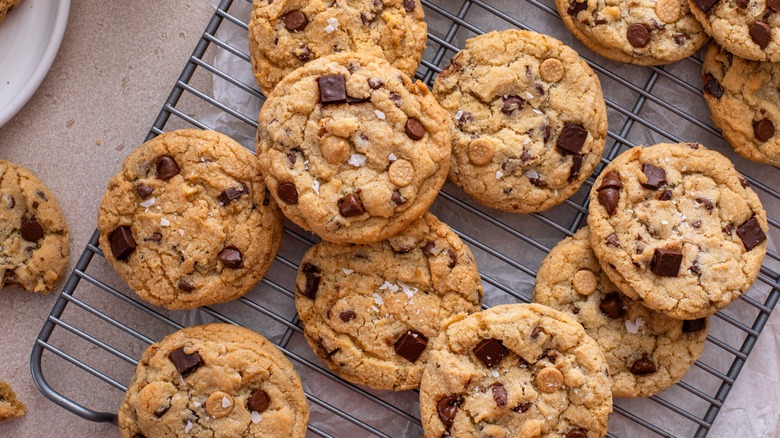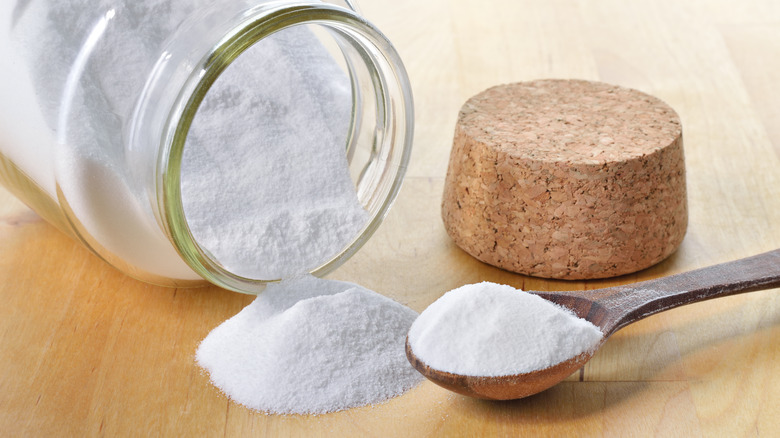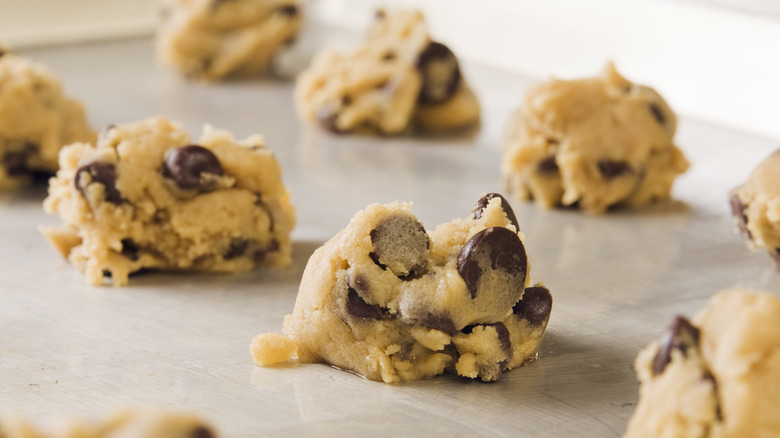For Better Cookies, Mix Baking Soda And Powder
If you want perfectly textured cookies, mixing leavening agents into the batter is essential. Most cookie recipes call for baking soda or baking powder, and the two can even be substituted with some slight modification. While it may seem redundant to use both, adding them can ensure sweet success by allowing the cookies to brown and spread a little more. Expansion is essential for evenly baked cookies since tightly compacted sweets could cause super soft (if not underdone) interiors and overbaked, crispy exteriors.
Baking soda is a strong base, meaning it increases the pH as it's mixed into cookie dough. This causes other ingredients to react, ultimately leading to extra movement for slightly larger cookies. The base weakens the gluten in the flour, which can help the cookies to grow a little more. The baking soda also slows down the eggs' protein coagulation, allowing the rest of the dough to finish cooking to a nice brown color. Meanwhile, baking powder creates carbon dioxide as it reacts inside the dough. This internal force can cause the cookies to stretch out, encouraging even bigger bakes.
Cookies made only with baking soda tend to bake up on the denser side while baking powder alone will yield lighter, fluffier treats. So adding both will result in more evenly baked desserts, resulting in some visible browning across the whole bake. The further the cookies spread, the more easily the oven's heat can evenly penetrate the dough.
How do baking soda and baking powder work?
Both ingredients have different requirements for activation, and when they're both met, the leavening agents work to improve the texture and color of your desserts. Baking soda needs an acid to begin working, which can be added during the mixing stage. It's made from sodium bicarbonate and reacts with ingredients like buttermilk, citrus, or vinegar to create carbon dioxide. As this gas is released in the cookie dough, the reaction spreads quickly to affect the other ingredients. The cookies may even begin to expand on the tray before they reach the oven, so work quickly.
There are two different kinds of baking powder, each with its specific restrictions. Single-acting baking powder only needs a little bit of liquid to work. Double-acting baking powder needs heat and works well for cookies requiring longer bake times. This variety usually contains two different components: Sodium bicarbonate and sodium aluminum sulfate.
The initial reaction with sodium bicarbonate occurs when the powder meets liquid, but a secondary reaction happens when heat is introduced to the sodium aluminum sulfate — like when the cookies are baked in the oven. This delayed reaction can allow the cookies to continue stretching out as they bake, ultimately leading to a more consistent texture.
Other ways to improve cookie dough
To amplify your cookies' texture even further, there are a few other things you can add. One unique secret ingredient for the softest chocolate chip cookies is tangzhong: a roux made from flour and milk or water. The paste helps increase the moisture content in the cookies, which means they'll stay soft and fresh for even longer. A little extra liquid in the dough can even allow the cookies to spread out even further.
While using two different leavening agents may allow for a better shape, mixing two different sugars can create spongy, cake-like cookies. White and brown sugars can be evenly substituted for one another, but they also interact differently with your dough. Of course, the textural shift is a bonus, but the molasses content of brown sugar can also diversify the flavor of the dough a little extra, making for a more delicious bite.
The temperature of your cookies can also impact how much they extend as they bake. Cold dough will hold its shape, but warmer dough is more likely to expand. If you're storing your cookie dough in the freezer, you may want to let it defrost and warm up a little prior to baking it unless you want a cakey cookie.



